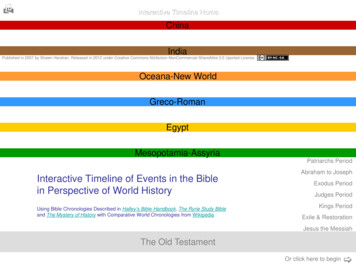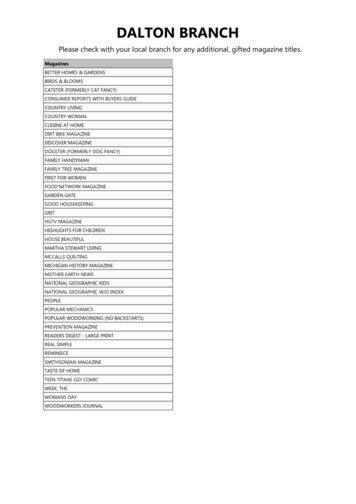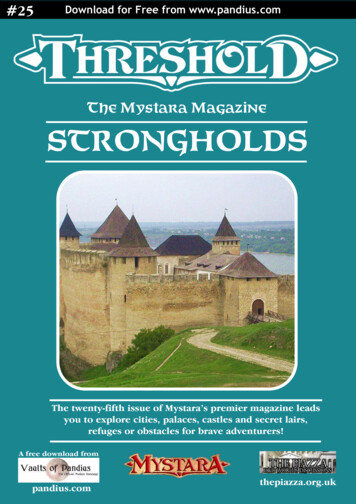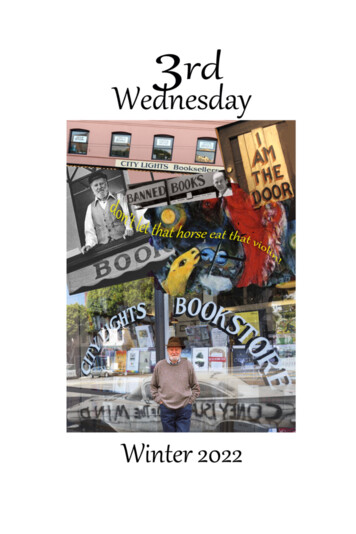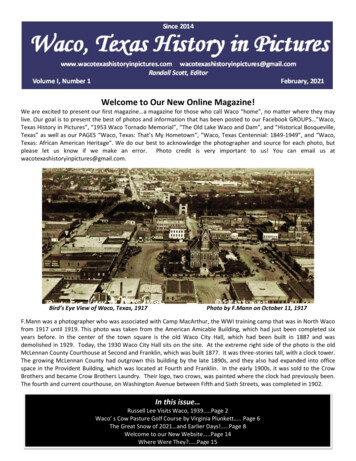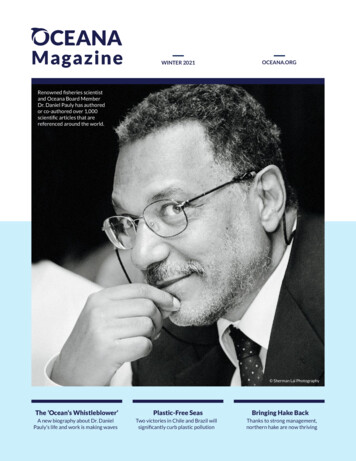
Transcription
MagazineWINTER 2021OCEANA.ORGRenowned fisheries scientistand Oceana Board MemberDr. Daniel Pauly has authoredor co-authored over 1,000scientific articles that arereferenced around the world. Sherman Lai PhotographyThe ‘Ocean’s Whistleblower’A new biography about Dr. DanielPauly’s life and work is making wavesPlastic-Free SeasTwo victories in Chile and Brazil willsignificantly curb plastic pollutionBringing Hake BackThanks to strong management,northern hake are now thriving
Board of DirectorsSam Waterston, ChairMaría Eugenia Girón, Vice ChairDiana Thomson, TreasurerJames Sandler, SecretaryKeith Addis, PresidentGaz AlazrakiHerbert M. Bedolfe, IIITed DansonNicholas DavisMaya GabeiraCésar GaviriaLoic GouzerJena KingBen KoernerSara LowellStephen P. McAllisterKristian Parker, Ph.D.Daniel Pauly, Ph.D.David Rockefeller, Jr.Susan RockefellerSimon Sidamon-EristoffRashid Sumaila, Ph.D.Valarie Van CleaveElizabeth WahlerJean WeissAntha WilliamsEditorial StaffEditorEmily PetskoDesignerAlan PoOcean CouncilSusan Rockefeller, FounderKelly Hallman, Vice ChairDede McMahon, Vice ChairAnonymousSamantha BassViolaine and John BernbachRick BurnesVin CipollaBarbara CohnAnn ColleyEdward DolmanKay and Frank FernandezCarolyn and Chris GroobeyJ. Stephen and Angela KilcullenAnn LuskeyMia M. ThompsonPeter NeumeierCarl and Janet NoletEllie Phipps PriceMaria Jose Peréz SimónDavid Rockefeller, Jr.Andrew SabinElias SacalRegina K. and John ScullySutton StrackeDavid Treadway, Ph.D.Edgar and Sue Wachenheim IIIValaree WahlerDavid Max WilliamsonRaoul WitteveenLeslie ZemeckisOceana StaffAndrew SharplessChief Executive OfficerJim SimonPresidentJacqueline SavitzChief Policy Officer, North AmericaKatie Matthews, Ph.D.Chief ScientistMatthew LittlejohnSenior Vice President, Strategic InitiativesJanelle ChanonaVice President, BelizeAdemilson Zamboni, Ph.D.Vice President, BrazilJoshua LaughrenExecutive Director, Oceana CanadaLiesbeth van der Meer, DVMVice President, ChilePascale MoehrleExecutive Director and Vice President, EuropeRenata TerrazasVice President, MexicoPatricia Majluf, Ph.D.Vice President, PeruGloria Estenzo Ramos, J.D.Vice President, PhilippinesNancy GoldenVice President, Global DevelopmentAbbie GibbsVice President, Institutional GivingSusan MurrayDeputy Vice President, U.S. PacificBeth LowellDeputy Vice President, U.S. CampaignsFSC LogoChristopher SharkeyChief Financial OfficerKathy WhelpleyChief of Staff, President’s OfficeMichael Hirshfield, Ph.D.Senior AdvisorPlease Recycle.Oceana Magazine is published by OceanaInc. For questions or comments about thispublication, please call our membershipdepartment at 1.202.833.3900 orwrite to Oceana’s Member Services at1025 Connecticut Ave. NW, Suite 200,Washington, DC 20036 USA.Oceana’s Privacy Policy: Your right to privacy is importantto Oceana, and we are committed to maintaining yourtrust. Personal information (such as name, address,phone number, email) includes data that you may haveprovided to us when making a donation or taking actionas a Wavemaker on behalf of the oceans. This personalinformation is stored in a secure location. For our fullprivacy policy, please visit oceana.org/privacy-policy.
FeaturesContents3 CEO NoteBoard Members Dr. Daniel Pauly and AnthaWilliams have made an indelible impact on Oceana4 For the WinBelize and Brazil strengthen transparency, theU.S. protects deep-sea corals, and more6 News & NotesOceana’s campaigns to protect endangeredwhales, stop offshore drilling, and more Oceana/Lucas Zañartu8 Q&AOceana’s plastic victoriesin Chile and BrazilOceana Science Advisor Dr. Jessica Gephartdiscusses new study on “blue foods”1010 Chile and Brazil Take On Big PlasticTwo recent victories in South America willsignificantly curb single-use plastic pollution18 A Tale of Two HakeWhy some hake in the Atlantic are thriving,and others are barely surviving24 Oceana’s VictoriesLooking back at our big wins over the last year25 Supporter Spotlight Shutterstock/judigoubarRead about the recovery ofnorthern hake in EuropeAntha Williams, the Environment Program lead atBloomberg Philanthropies, joins Oceana’s Board1826 Ask Dr. PaulyDaniel Pauly talks to Scientific American aboutmarine sanctuaries, subsidies, and moreTo help navigate Oceana’s work, look for these sixicons representing our major 0 EventsOceana’s New York Gala and SeaChange eventsraise over 3.3 million for ocean conservation34 Chef’s CornerChef Bun Lai shares a simple and delicious recipe forAsian shore crabs, an invasive species in the U.S.36 Parting ShotDive into Oceana’s expedition to Bajos del NorteNational Park, Mexico1
Your support makesan ocean of differencePlease Give Generously TodayA healthy, fully restored oceancould sustainably feed morethan 1 billion people each day.Call us today at (202) 833-3900, email us atinfo@oceana.org, visit www.oceana.org/give,or use the envelope provided in this magazineto make a donation. Oceana is a tax-exempt501(c)3 organization and contributions aretax-deductible to the fullest extent of the law. Steve de Neef
CEO Note Oceana/Perrin James Ryan MillerDear Friends:Dr. Daniel Pauly is on the coverof this issue of our magazine, andif you do not know who he is, youwill be pleased to meet him here.His research on the oceans hasmade him the most frequently citedocean scientist in the world. Hislife, extraordinary for the scopeof his research and insight (hiscareer included long periods livingand studying in Indonesia and thePhilippines, followed by his currenthome in Canada), is even moreamazing when you learn about hisyouth. He was born in France, thechild of a Black American soldierand French mother, and adoptedinto a family in Switzerland. At 16,he dropped out of high school andmoved to Germany to work in aLutheran asylum, followed by a cityhospital. Only later did he returnto school, studying in the eveningand working odd jobs during theday (including at a paint factory andbrush factory) to support himself.How does a person from such adisadvantaged start rise to be oneof the most important people inthe history of the world’s oceans?You can get insight into the answerfrom his biography, The Ocean’sWhistleblower: The RemarkableLife and Work of Daniel Pauly, justpublished this year. You can alsosee his interview, first published inDr. Daniel Pauly, his wife Sandra, and Oceana Board Member Valarie Van Cleave at Oceana’srecent SeaChange eventScientific American and republishedhere on page 26.Dr. Pauly is one of Oceana’s longestserving board members, and wehave benefited from his scientificadvice and strategic sensibility sinceour earliest days. Joining him forthe first time on our board at ourmost recent board meeting is AnthaWilliams, who someday will alsointrigue a biographer’s interest. Sheleads the Environment Program atBloomberg Philanthropies, and forsix years she has been a key adviserand strategic force behind our“Save the Oceans, Feed the World”campaigns. Her expertise includesa deep knowledge of grassrootscampaigning gained from personalexperience as a campaigner andtrainer of organizers. You can learnmore about her in the “SupporterSpotlight” section of this issue onpage 25.The combination of a world-classmarine scientist and a worldclass grassroots campaigner andstrategist on Oceana’s board is avivid illustration of the mix of skillsthat enables us to win nationalscale ocean conservation policyoutcomes. Our campaigns requireus to confront powerful and selfinterested companies that areoverfishing and polluting our oceans.3Winning policy battles against them,even in countries led by notableanti-conservation presidents –Brazil’s Bolsonaro, to mentionone – requires us to be effectiveat science, law, communications,direct advocacy, and grassrootsorganizing. Happily, we rise to thatdifficult challenge, as our newestset of policy and corporate victories– including remarkable ones inChile and Brazil controlling plasticpollution – make clear. Enjoy readingabout them in this magazine on page10.Reporting policy outcomes to youin every issue of our magazine,published thrice a year, is one ofthe great pleasures of servingas Oceana’s CEO. I never forgetthat these victories are possibleonly thanks to the generouscontributions of our backers, and asa reader of this magazine, you arelikely one of them. Thank YOU!Together, we are steadily winningthe policies that will restore anabundant ocean.Sincerely,Andy SharplessCEOOceanaWINTER 2021 Oceana.org
For the Win NOAA Office of Ocean Exploration and ResearchCup corals and a sea star were spotted a mile beneath the ocean’s surface in Heezen Canyon, located off the coast of the Northeast United States.U.S. fisheries agency protects New England deep-seacorals from destructive fishing gearand its allies campaigned for – to nearly 86,000 squaremiles (222,700 square kilometers). This is importantbecause deep-sea corals can be long-lived and slowgrowing. They provide essential habitat to fish and othermarine animals, making them – and countless otherspecies – vulnerable to disruptions along the seafloor.The U.S. National Marine Fisheries Service issueda final rule to protect over 25,000 square miles(64,700 square kilometers) of New Englanddeep-sea corals from bottom trawls, a destructivefishing method that is comparable to clear-cutting aforest. The agency implemented a “freeze the footprint”strategy developed by Oceana to limit bottom trawlingto areas where it has already occurred, preventing itsexpansion into new areas.“Fishing gear like bottom trawls and dredges act likebulldozers on the ocean floor, destroying centuries’worth of coral in only a few seconds,” said OceanaSenior Campaign Manager Gib Brogan. “Protectingdeep-sea corals is a win-win for both fishermen andhealthy oceans. Healthy corals will help sustain robustfisheries and ocean ecosystems for years to come.”These protections apply to Georges Bank and the Gulfof Maine, covering an area roughly the size of Vermont,New Hampshire, Connecticut, and Rhode Islandcombined. This brings the total protected deep-seacoral areas in the U.S. Atlantic – many of which OceanaOceana continues to identify and protect deep-seacoral areas from destructive fishing methods while alsomaintaining robust fisheries.4
Belize agrees to publish vessel tracking data forcommercial fishing fleetrebuked Belize for failing to address IUU activities. Thebloc banned Belizean imports the following year to keepillegally caught seafood out of European markets.Belize is the most recent country to publiclyshare its vessel tracking data on the GlobalFishing Watch (GFW) platform, helpingauthorities detect and address illegal, unreported,and unregulated (IUU) fishing when it occurs. Theagreement – signed by Oceana, GFW, and the BelizeHigh Seas Fisheries Unit – resulted from Oceana’scollaboration with the government to make fishing onthe high seas more transparent. This agreement willallow anyone to monitor Belizean-flagged commercialfishing vessels in near real-time.In response, the Government of Belize made sweepingchanges, including regaining control of the nationalships registry and passing legislation that created theBelize High Seas Fisheries Unit to regulate high seasfishing. Oceana continues to campaign for governmentaction against illegal fishing.“This is a demonstration of Belize’s fervent commitmentto transparency and good governance,” said JanelleChanona, Oceana’s leader in Belize. “The use of GFWtechnology is cost-effective, efficient, and enhancesvessel monitoring.”Belize has taken decisive steps to improve themonitoring and regulation of its flagged vessels onthe high seas since 2012, when the European Union Shutterstock/Al McGlashanTuna are a common species caught by Belizean vessels.Chilean court rules in favor of science-basedmanagement for overfished southern hakeBrazilian government restores Fisheries ManagementCouncilsAn environmental court in Santiago, Chile, ruledthat a government decision to increase theglobal fishing quota for southern hake was illegal.The Undersecretariat for Fisheries and Aquaculture(Subpesca) increased the quota for the year 2019,even though southern hake have been overexploitedin Chile’s waters since 2013. The Ministry of Economyrefused to invalidate this increase, ignoring the adviceof an independent scientific committee, so Oceana tookmatters into its own hands and filed a legal complaint.Following campaigning by Oceana, FisheriesManagement Councils (FMCs) were restoredin Brazil after the government created a newframework for fisheries decision-making called “RedePesca Brasil.”FMCs, which the government previously terminated in2019, support a transparent and participatory decisionmaking process for Brazil’s fisheries.The 10 FMCs will allow the government, scientists,fishers, and non-governmental organizations todiscuss important topics including fishing quotas anddestructive forms of fishing like bottom trawling.The 2nd Environmental Court of Santiago ruled thatSubpesca had failed to justify the quota increase andhad flouted precautionary measures that were put inplace to protect marine ecosystems. The decision wasprecedent-setting in two ways: First, it confirmed thatenvironmental courts have jurisdiction over fisheriesmanagement plans. Second, it reinforced the need forscience in fisheries decision-making.“Oceana has been campaigning for broader reformwithin Brazil’s fisheries policy to make the managementframework more stable,” said Martin Dias, Oceana’sscience director in Brazil. “The government’s decision torestore FMCs is important progress toward that goal.”After ensuring that the environmental court’s rulingis enforced, Oceana will continue to campaign for theimproved management of southern hake across Chile.5WINTER 2021 Oceana.org
News Notes Ricardo GomesFishers in the northeastern Brazilian state of Rio Grande do Norte attended the launch of OpenTuna, a website that Oceana and Global FishingWatch helped develop. For the first time, it publicizes the catch data and vessel monitoring system data for Brazil’s tuna longline fleet.Fishing transparency platformthat Oceana helped develop winsinternational sustainability awardOpenTuna, an initiative thatOceana and Global FishingWatch helped develop totrack Brazil’s tuna longline fleet,won the sustainability categoryof this year’s international TunaAwards. Hosted by the NationalAssociation of Canned and FishManufacturers in partnership withthe Spanish Ministry of Agriculture,Fisheries, and Food, the awardrecognizes initiatives that promoteinnovation in the global tunaindustry, which supports about6,000 jobs in Brazil alone.The OpenTuna website (opentuna.org) publicizes catch data andvessel monitoring system data forBrazil’s tuna fleet, helping to makethe industry more transparent. Itwas developed in cooperation withfishing companies and launchedearlier this year.Oceana report: Majority ofvessels not complying with speedlimits in areas meant to protectendangered North Atlantic rightwhalesMost vessels along the U.S.Atlantic Coast are speedingin areas designed to protectcritically endangered NorthAtlantic right whales, according toan Oceana analysis of vessel speedsfrom 2017 to 2020.In one area, stretching fromWilmington, North Carolina, toBrunswick, Georgia, nearly 90% ofvessels ignored mandatory speedlimits. Even the area with the “best”compliance rate failed to meetexpectations, with only about twothirds of vessels slowing down formandatory speed restrictions nearCape Cod, Massachusetts.Vessel strikes and fishing gearentanglements are the two leadingcauses of death for North Atlantic6right whales, whose populationhas been reduced to less than 340whales. Studies have shown thatslowing a vessel’s speed to 10 knots(about 11.5 miles per hour, or 18.5kilometers per hour) can reduce aNorth Atlantic right whale’s risk ofdeath by up to 90%. In 2008, theNational Oceanic and AtmosphericAdministration (NOAA) enactedspeed zones to help protect thesewhales, but Oceana’s reporthighlights the shortcomings ofthese measures.“If NOAA is serious about itsmandate to save North Atlanticright whales from extinction, speedzones must be designated in theareas where whales currentlyare, and they must be enforced,”said Oceana Campaign DirectorWhitney Webber. “Until speed zonerules are mandatory and violatorsheld accountable, North Atlanticright whales will continue to die onNOAA’s watch.”
increase the number of vesselsvisible on this map, governmentsshould mandate AIS for all fishingvessels so they can be monitoredand held accountable for theiractions at sea.”To use this tool, visit usa.oceana.org/IUUVesselTracker. Global Fishing WatchGlobal fishing activity in 2020 is shown inyellow.Oceana launches vessel-trackingtool to curb illegal fishingUsing data from GlobalFishing Watch, anindependent non-profitfounded by Oceana, SkyTruth, andGoogle in 2015, Oceana createda new tool to keep tabs on vesselsthat have histories of unlawfulfishing activities. The tool usesautomatic identification system(AIS) data to map the movementsof vessels that have been listed onillegal, unreported, and unregulated(IUU) vessel lists by regionalmanagement bodies. Dubbed theIUU Vessel Tracker, it lets userssee where these IUU-listed vesselshave apparently been fishing ortransiting fish over a one-monthperiod.U.S. House-passed federalspending bill blocks expansion ofoffshore drillingA federal spending billapproved by the U.S.House of Representativeswould prevent the Bureau ofOcean Energy Managementfrom expanding offshore drillingin fiscal year 2022. If enacted, itwould prohibit offshore drillingin unleased areas of the Atlantic,Pacific, and Arctic Oceans, as wellas the Eastern Gulf of Mexico.It would also stop the bureau fromgranting permits for seismic airgunblasting in these areas. Seismicairguns are used to find oil and gasreserves beneath the seafloor. Inthe process, they create one of theloudest human-made sounds in theocean, which can disturb, injure, oreven kill marine animals.Though there are more than 160vessels on the list, only two arevisible because the rest are notbroadcasting an AIS signal. AISdevices automatically broadcastvessel identity and locationinformation (such as coordinates,speed, and direction) as oftenas once every few seconds.In order for the IUU VesselTracker to reach its full potential,though, governments must maketransparency within the fishingsector a priority.“These vessels are now on notice– we are watching them,” saidBeth Lowell, Oceana’s deputy vicepresident for U.S. campaigns. “ToMeanwhile, new offshore drillingis still being proposed. Five daysbefore Hurricane Ida made landfallin Southern Louisiana over thesummer, the Department of theInterior announced that it wouldhold a lease sale for offshore drillingin the Gulf of Mexico, coveringapproximately 80 million acres. TheU.S. Coast Guard has since receivedover 2,000 reports of pollution,including multiple oil spills causedby the storm.On the West Coast, Oceana hasbeen monitoring the effects of adevastating pipeline rupture offthe coast of Huntington Beach,California, that released roughly25,000 gallons of crude oil into theocean in October.Oceana mapped the locationsof ecologically diverse andeconomically valuable oceanresources that are most susceptibleto oil contamination in that area.Deep-water corals, endangeredblue whales, migrating gray whales,kelp forests, and many other speciesare at risk.Oceana continues to campaignfor permanent protections fromoffshore drilling in the UnitedStates. Shutterstock/nektofadeevAn Oceana analysis found that ending new leasing for offshore oil and gas could prevent over19 billion tons of greenhouse gas emissions as well as more than 720 billion in damages topeople, property, and the environment. Additionally, it will safeguard the U.S. clean coasteconomy, which supports around 3.3 million jobs and 250 billion in GDP through activitiessuch as tourism, recreation, and fishing.7WINTER 2021 Oceana.org
Q AOceana Science AdvisorDr. Jessica Gephart leadsnew study on ‘blue foods’What unanswered questionsdid you want to address in yourEnvironmental performance of bluefoods paper?Dr. Jessica Gephart is an OceanaScience Advisor and an AssistantProfessor of Environmental Science atAmerican University in Washington,D.C., where she studies the seafoodtrade and its impact on food securityand environmental conservation.Gephart’s research has also informedOceana’s Save the Oceans, Feedthe World initiative. Recently, sheled a study that compared theenvironmental impact of variousaquatic foods. She and 17 otherscientists – including fellow OceanaScience Advisor Dr. ChristopherGolden – calculated the greenhousegas, nitrogen, and phosphorousemissions, as well as the freshwaterand land use, of “blue foods.” Bluefoods as a category include captureproducts (or “wild” foods fromthe ocean and inland waters) andaquaculture products (or farmed fishand shellfish). In a recent conversationwith Oceana, Gephart discussedthis paper, which appeared in Naturejournal in September as part of theglobal Blue Food Assessment led bythe Stockholm Resilience Center,Stanford University, and EAT.JG: Our aim was to fill an importantinformation gap by generatingstandardized estimates of theenvironmental performance ofaquatic foods, focusing on the majorenvironmental pressures of foodsystems: greenhouse gas emissions,nitrogen and phosphorus emissions,and land and freshwater use. Thisallowed us to look at which bluefoods were already performingwell and identify improvementopportunities.Your study assessed 70% of theworld’s blue food production.What accounts for the other 30%?JG: With over 2,500 differentspecies of aquatic animals andplants caught or cultivated forfood around the world, there aremany for which there is insufficientdata. For example, despite ourefforts, we were not able to identifysufficient, representative fuel usedata for inland fisheries. We werealso unable to include freshwatercrustacean aquaculture due tolimited data. There are other groups8that are included in our analysis, buthave few observations comparedto global production, such as edibleseaweeds and carps. These allrepresent priority areas for futureresearch.How does your study differ frompast research on blue foods?JG: One thing that sets our studyapart from many studies thatlook at emissions and resourceuse across the food system isthat we include both aquacultureand capture fisheries, and weprovide greater species resolution,whereas many past studies eitherdid not include blue foods at all orpresented them as “seafood.” Ourwork therefore provides greaterinsights across the vast diversity ofaquatic food production. Anothermajor advancement is that we didnot simply average the emissionand resource use estimates ofdifferent studies, but insteadextracted the underlying dataand ran it through a standardizedmodel. This is because individualstudies have different purposes andtherefore make modeling decisionsthat heavily influence the results,often preventing these studies frombeing able to be compared fairly.
Based on your results, what aresome of the lowest-impact wildand aquaculture foods on themarket, and what makes them sosustainable?already outperform chickenon these five environmentalmetrics, on average, with chickenperforming similarly to tilapia.JG: It is important to note thatour analysis does not look at finalimpacts, such as biodiversityloss, but only focuses on majoremissions and resource use. Forthe five stressors considered,capture fisheries use negligibleland and water and emit littlenitrogen and phosphorus, butresult in a range of greenhouse gasemissions. However, small pelagicfishes, such as sardines, generatelower greenhouse gas emissionsthan all fed aquaculture groups.Farmed seaweed and bivalves, suchas mussels, result in the lowestemissions and resource use of allblue foods, while among farmedfinfish and crustaceans, silver andbighead carps have the lowestgreenhouse gas, nitrogen, andphosphorus emissions, and salmonand trout use the least water andland.What do you want policymakersto take away from this paper?JG: When steering food productiontoward greater sustainability,it is not only critical to considerblue foods alongside terrestrialfoods, but also to look across thediversity of blue food production.Many seafood systems provideblue foods at relatively lowenvironmental costs, and forothers there are opportunities toreduce environmental pressures.For aquaculture, improving feedconversion ratios – that is, theamount of feed required to grow acertain weight of fish – can reducethe emissions of some fed fish bymore than half.Meanwhile, capture fisheriesalready have negligible freshwaterand land use and emit little nitrogenand phosphorus, but there aregreat opportunities to lower thegreenhouse gas emissions byimproving management, prioritizingless fuel-intensive gear, andinvesting in renewable energy forfishing fleets. While this points toa promising role for blue foods insustainable diets, decisionmakersmust consider their local contextto ensure sustainable stockmanagement and avoid impacts onaquatic biodiversity.Small pelagic fishes, such as sardines,generate lower greenhouse gas emissionsthan all fed aquaculture groups.How does wild seafood compareto land-based animal proteinsin terms of the environmentalimpacts you assessed?JG: We compared blue foodperformance to industrial chickenperformance, as this is oftenconsidered the most efficientterrestrial animal-source food.Many blue foods, such as sardines,cods, tunas, salmon, and bivalves, Shutterstock/Andrea IzzottiSmaller fish like sardines (pictured fleeing striped marlin) are often a sustainable choicebecause they have a low carbon footprint and require no freshwater or land to harvest.9WINTER 2021 Oceana.org
FeatureChile and Braziltake on Big PlasticRecent examples from two coastal countries in South America showthat policy change and corporate commitments are achievable meansof reducing single-use plastic pollution.1010 Shutterstock/marcin jucha
Imagine that every minute ofevery day, two dump trucks full ofsingle-use plastic drive onto thebeach, back up to the shoreline,and raise their beds, sending atorrent of trash into the ocean. Thisis essentially what’s happeningaround the world, with nearly 15million metric tons of mismanagedplastic – or 33 billion pounds –polluting marine ecosystems eachyear.Compared to other continents thatconsume ample amounts of plastic,South America isn’t the world’sworst offender. Nevertheless, keyplayers in two South Americancountries are taking bold actionto curb single-use plastics. Earlierthis year, the Chilean governmentpassed a law that will practicallyeliminate single-use plastics fromthe food and beverage sector, whilealso bringing refillable beveragebottles back to supermarkets andstores for the first time in decades.Less than three months later andon the opposite coast, the Braziliancompany iFood – a market leader inonline food ordering and delivery– agreed to drastically reduce theamount of single-use plastic it givescustomers. In doing so, it makestakeout a more environmentallyfriendly option for millions. Oceana/Lucas ZañartuSingle-use plastic foodware from restaurants, such as clamshell containers and disposableutensils, are common items found on Chile’s beaches. Shutterstock/AdriWhen people think about the effects of plastic on marine life, turtles usually come to mind.However, seabirds and many other animals also die or become seriously injured after eating orbecoming entangled in plastics.businesses to take responsibility fortheir plastic waste, and corporateled changes attract public attentionand make it easier for lawmakers topass meaningful plastic legislation.These victories would not havebeen possible without campaigningby Oceana and its allies, includingPlastic Oceans Chile, the Clean SeasCampaign of the United NationsEnvironment Program (UNEP) inBrazil, and the thousands of peopleacross both countries who spokeout and demanded plastic-freeoptions.These complementary strategies,proven successful in Chile andBrazil, could convince othercountries and companies that it’spossible to meaningfully reduceplastic waste and protect oceans.Oceana fights plastic pollutionin two ways: by campaigningfor plastic-free policies and bypersuading powerful companies toreduce their environmental impact.Well-designed policies requireChile’s new law will all but eliminatethe estimated 23,000 metrictons of single-use plastic thatrestaurants, cafes, and other foodestablishments discard each year inChile.Fries and a shake,sans plastic11The law will achieve this byrequiring dine-in eateries to phaseout all disposable tableware –including plastic cutlery, cups,straws, expanded polystyrene(such as Styrofoam) containers, andmore – by 2024. As for delivery andtake-out orders, customers mustbe offered foodware that is plasticfree or made of certified plastic. Thelatter material is sometimes neededfor containers that hold liquids, butit must be made from renewableraw materials (as opposed to fossilfuels) and must be able to breakdown in a home composting bin orindustrial composting facility.While most restaurants alreadyprovide reusable utensils todine-in customers, throwawayplastics are ubiquitous in fast foodsettings, explained Catalina Sapag,WINTER 2021 Oceana.org
Featurea Santiago-based science andcampaigns coordinating managerfor Oceana. That won’t be true formuch longer, though.“Three years from now, if you go toa food court in a shopping centeror sit down to eat at a McDonald’sin Chile, all the foodware they giveyou will be reusable,” Sapag said. “Ipersonally wouldn’t have been ableto imagine this.”The law also requires storesto display, sell, and receiverefillable beverage bottles. Largersupermarkets must comply bynext February, followed by smaller
Oceana Magazine is published by Oceana Inc. For questions or comments about this publication, please call our membership department at 1.202.833.3900 or write to Oceana’s Member Services at 1025 Connecticut Ave. NW, Suite 200, Washington, DC 20036 USA. Board of Directors Sam Waterston
